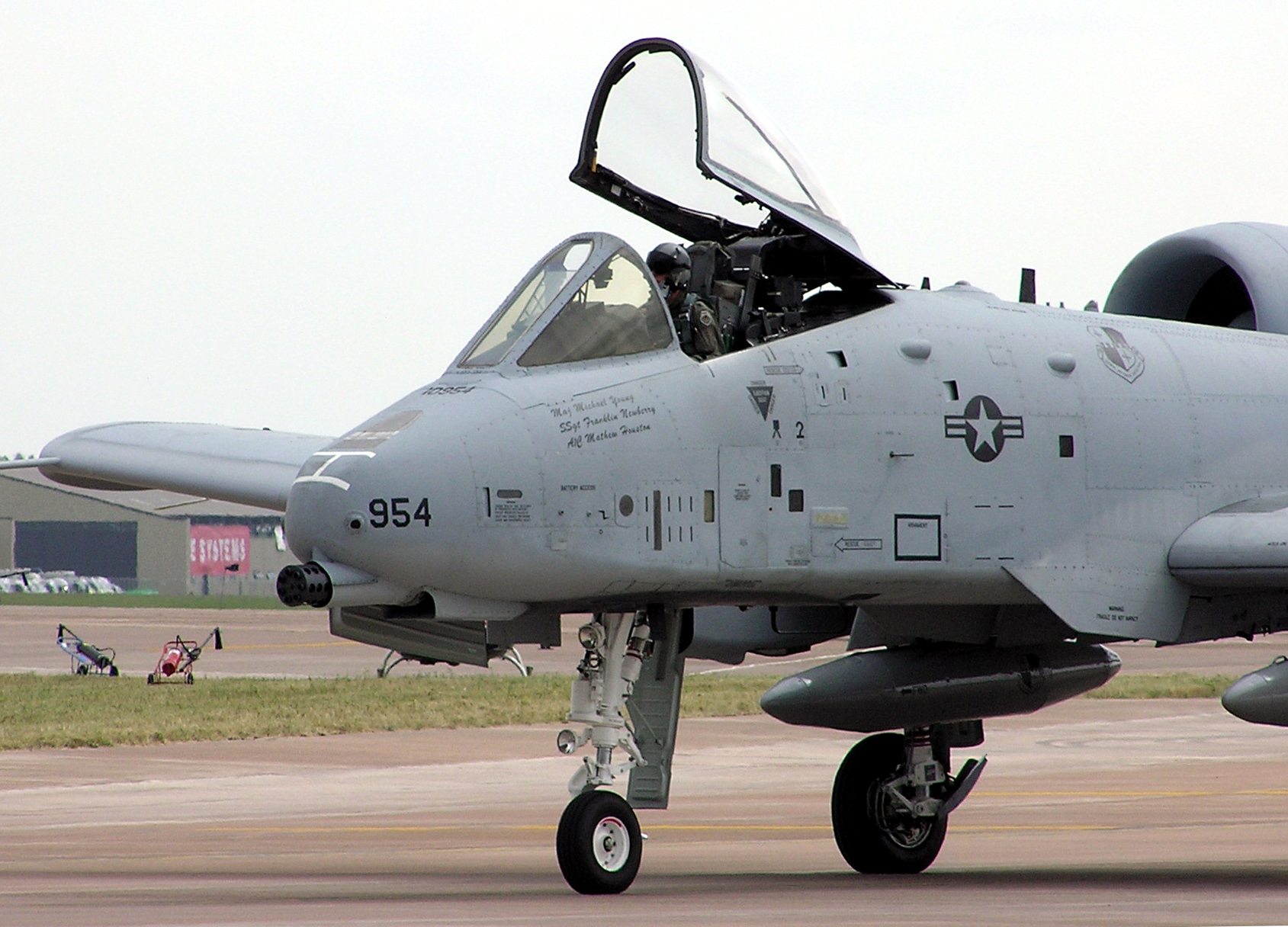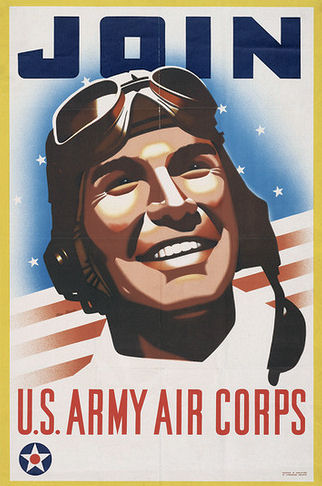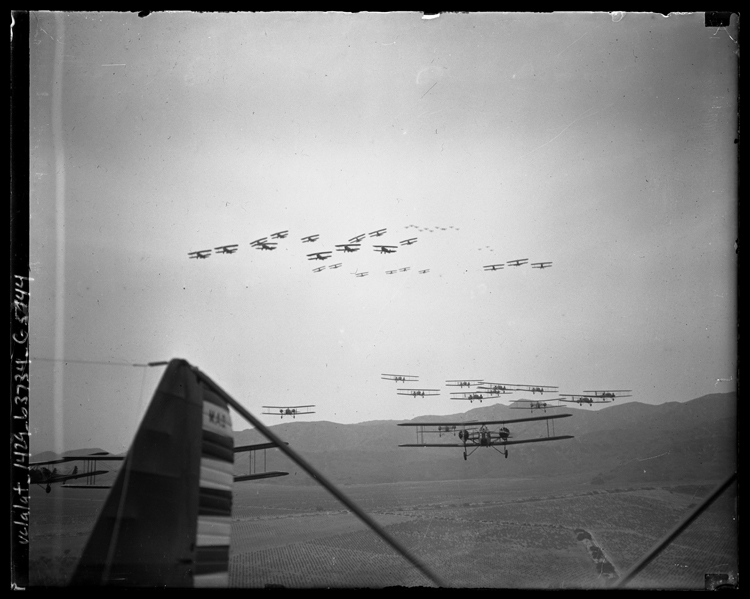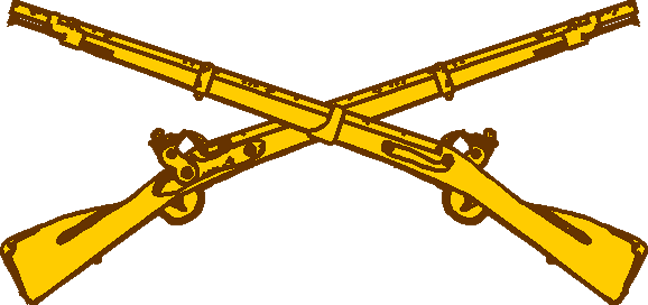|
USAAC
The United States Army Air Corps (USAAC) was the aerial warfare service component of the United States Army between 1926 and 1941. After World War I, as early aviation became an increasingly important part of modern warfare, a philosophical rift developed between more traditional ground-based army personnel and those who felt that aircraft were being underutilized and that air operations were being stifled for political reasons unrelated to their effectiveness. The USAAC was renamed from the earlier United States Army Air Service on 2 July 1926, and was part of the larger United States Army. The Air Corps became the United States Army Air Forces (USAAF) on 20 June 1941, giving it greater autonomy from the Army's middle-level command structure. During World War II, although not an administrative echelon, the Air Corps (AC) remained as one of the combat arms of the Army until 1947, when it was legally abolished by legislation establishing the Department of the Air Force. The A ... [...More Info...] [...Related Items...] OR: [Wikipedia] [Google] [Baidu] |
United States Military Aircraft National Insignia
This is a listing of the nationality markings used by military aircraft of the United States, including those of the U.S. Air Force, U.S. Navy, U.S. Marine Corps, U.S. Coast Guard, U.S. Army and their predecessors. The Civil Air Patrol is also included for the World War II period because it engaged in combat operations (primarily anti-submarine flights) which its July 1946 charter has since explicitly forbidden. History The first military aviation insignias of the United States include a star used by the US Army Signal Corps Aviation Section, seen during the Pancho Villa punitive expedition, just over a year before American involvement in World War I began. The star was painted only on the vertical tail, in either red (the most often used color) or blue (less likely, due to the strictly orthochromatic photography of that era, rendering the red star as a black one in period photos). At the same time, the US Navy was using a blue anchor on the rudders of its seaplanes. Afte ... [...More Info...] [...Related Items...] OR: [Wikipedia] [Google] [Baidu] |
USAAC Roundel 1919-1941
The United States Army Air Corps (USAAC) was the aerial warfare service component of the United States Army between 1926 and 1941. After World War I, as early aviation became an increasingly important part of modern warfare, a philosophical rift developed between more traditional ground-based army personnel and those who felt that aircraft were being underutilized and that air operations were being stifled for political reasons unrelated to their effectiveness. The USAAC was renamed from the earlier United States Army Air Service on 2 July 1926, and was part of the larger United States Army. The Air Corps became the United States Army Air Forces (USAAF) on 20 June 1941, giving it greater autonomy from the Army's middle-level command structure. During World War II, although not an administrative echelon, the Air Corps (AC) remained as one of the combat arms of the Army until 1947, when it was legally abolished by legislation establishing the Department of the Air Force. The Ai ... [...More Info...] [...Related Items...] OR: [Wikipedia] [Google] [Baidu] |
United States Army Air Corps
The United States Army Air Corps (USAAC) was the aerial warfare service component of the United States Army between 1926 and 1941. After World War I, as early aviation became an increasingly important part of modern warfare, a philosophical rift developed between more traditional ground-based army personnel and those who felt that aircraft were being underutilized and that air operations were being stifled for political reasons unrelated to their effectiveness. The USAAC was renamed from the earlier United States Army Air Service on 2 July 1926, and was part of the larger United States Army. The Air Corps became the United States Army Air Forces (USAAF) on 20 June 1941, giving it greater autonomy from the Army's middle-level command structure. During World War II, although not an administrative echelon, the Air Corps (AC) remained as one of the combat arms of the Army until 1947, when it was legally abolished by legislation establishing the Department of the Air Force. The A ... [...More Info...] [...Related Items...] OR: [Wikipedia] [Google] [Baidu] |
United States Army Air Service
The United States Army Air Service (USAAS)Craven and Cate Vol. 1, p. 9 (also known as the ''"Air Service"'', ''"U.S. Air Service"'' and before its legislative establishment in 1920, the ''"Air Service, United States Army"'') was the aerial warfare service component of the United States Army between 1918 and 1926 and a forerunner of the United States Air Force. It was established as an independent but temporary branch of the U.S. War Department during World War I by two executive orders of President Woodrow Wilson: on May 24, 1918, replacing the Aviation Section, Signal Corps as the nation's air force; and March 19, 1919, establishing a military Director of Air Service to control all aviation activities., p. 149, Appendix 2 Redesignations of the Army Air Arm, 1907–1942. Its life was extended for another year in July 1919, during which time Congress passed the legislation necessary to make it a permanent establishment. The National Defense Act of 1920 assigned the Air Service ... [...More Info...] [...Related Items...] OR: [Wikipedia] [Google] [Baidu] |
Benjamin Foulois
Benjamin Delahauf Foulois (December 9, 1879 – April 25, 1967) was a United States Army general who learned to fly the first military planes purchased from the Wright brothers. He became the first military aviator as an airship pilot, and achieved numerous other military aviation "firsts". He led strategic development of the Air Force in the United States. Early life Benjamin "Benny" Delahauf Foulois was born on December 9, 1879, in Washington, Connecticut, to a Franco-American pipe-fitter and a Boston-born nurse. Early military service At age 18, he used his older brother's birth certificate to enlist in the Army to support the Spanish–American War, but arrived in Puerto Rico just weeks before the armistice was signed. As an engineer, he fought off the rampant tropical diseases, and after five months, was shipped home and mustered out. On June 17, 1899, Foulois enlisted again, using his own name, as a private in the Regular Army and was assigned to the 19th Infantry, wher ... [...More Info...] [...Related Items...] OR: [Wikipedia] [Google] [Baidu] |
United States Army Air Forces
The United States Army Air Forces (USAAF or AAF) was the major land-based aerial warfare service component of the United States Army and ''de facto'' aerial warfare service branch of the United States during and immediately after World War II (1941–1945). It was created on 20 June 1941 as successor to the previous United States Army Air Corps and is the direct predecessor of the United States Air Force, today one of the six armed forces of the United States. The AAF was a component of the United States Army, which on 2 March 1942 was divided functionally by executive order into three autonomous forces: the Army Ground Forces, the United States Army Services of Supply (which in 1943 became the Army Service Forces), and the Army Air Forces. Each of these forces had a commanding general who reported directly to the Army Chief of Staff. The AAF administered all parts of military aviation formerly distributed among the Air Corps, General Headquarters Air Force, and the groun ... [...More Info...] [...Related Items...] OR: [Wikipedia] [Google] [Baidu] |
United States Congress
The United States Congress is the legislature of the federal government of the United States. It is bicameral, composed of a lower body, the House of Representatives, and an upper body, the Senate. It meets in the U.S. Capitol in Washington, D.C. Senators and representatives are chosen through direct election, though vacancies in the Senate may be filled by a governor's appointment. Congress has 535 voting members: 100 senators and 435 representatives. The U.S. vice president has a vote in the Senate only when senators are evenly divided. The House of Representatives has six non-voting members. The sitting of a Congress is for a two-year term, at present, beginning every other January. Elections are held every even-numbered year on Election Day. The members of the House of Representatives are elected for the two-year term of a Congress. The Reapportionment Act of 1929 establishes that there be 435 representatives and the Uniform Congressional Redistricting Act requires t ... [...More Info...] [...Related Items...] OR: [Wikipedia] [Google] [Baidu] |
Interwar Period
In the history of the 20th century, the interwar period lasted from 11 November 1918 to 1 September 1939 (20 years, 9 months, 21 days), the end of the First World War to the beginning of the Second World War. The interwar period was relatively short, yet featured many significant social, political, and economic changes throughout the world. Petroleum-based energy production and associated mechanisation led to the prosperous Roaring Twenties, a time of both social mobility and economic mobility for the middle class. Automobiles, electric lighting, radio, and more became common among populations in the developed world. The indulgences of the era subsequently were followed by the Great Depression, an unprecedented worldwide economic downturn that severely damaged many of the world's largest economies. Politically, the era coincided with the rise of communism, starting in Russia with the October Revolution and Russian Civil War, at the end of World War I, and ended with the ri ... [...More Info...] [...Related Items...] OR: [Wikipedia] [Google] [Baidu] |
World War
A world war is an international conflict which involves all or most of the world's major powers. Conventionally, the term is reserved for two major international conflicts that occurred during the first half of the 20th century, World WarI (1914–1918) and World WarII (1939–1945), although historians have also described other global conflicts as world wars, such as the Seven Years' War and the Cold War. Etymology The ''Oxford English Dictionary'' cited the first known usage in the English language to a Scottish newspaper, ''The People's Journal'', in 1848: "A war among the great powers is now necessarily a world-war." The term "world war" is used by Karl Marx and his associate, Friedrich Engels, in a series of articles published around 1850 called ''The Class Struggles in France''. Rasmus B. Anderson in 1889 described an episode in Teutonic mythology as a "world war" (Swedish: ''världskrig''), justifying this description by a line in an Old Norse epic poem, " Völuspá: ... [...More Info...] [...Related Items...] OR: [Wikipedia] [Google] [Baidu] |
1941 In Aviation
This is a list of aviation-related events from 1941: Events * Jackie Cochran became the first woman to fly a bomber across the Atlantic Ocean. * During the spring and summer, the Imperial Japanese Navy's air arm conducts Operation 102, its second major bombing campaign against Chungking. * By early autumn, the Imperial Japanese Navy has turned all air operations on the Chinese mainland over to the Imperial Japanese Army.Peattie, Mark R., ''Sunburst: The Rise of Japanese Naval Air Power 1909-1941'', Annapolis, Maryland: Naval Institute Press, 2001, , p. 122. * The Aeronautical Corporation of America renames itself Aeronca. January * The ''Regia Aeronautica'' (Italian Royal Air Force) withdraws all bombers and biplane fighters from the '' Corpo Aereo Italiano'' (Italian Air Corps)—its expeditionary force based in Belgium for operations against the United Kingdom—leaving only Fiat G.50 Freccia monoplane fighters in the ''Corpo''.Wikipedia Corpo Aereo Italiano article. * Th ... [...More Info...] [...Related Items...] OR: [Wikipedia] [Google] [Baidu] |
Executive Order
In the United States, an executive order is a directive by the president of the United States that manages operations of the federal government. The legal or constitutional basis for executive orders has multiple sources. Article Two of the United States Constitution gives presidents broad executive and enforcement authority to use their discretion to determine how to enforce the law or to otherwise manage the resources and staff of the executive branch. The ability to make such orders is also based on expressed or implied Acts of Congress that delegate to the president some degree of discretionary power ( delegated legislation).John Contrubis, '' Executive Orders and Proclamations'', CRS Report for Congress #95-722A, March 9, 1999, Pp. 1-2 The vast majority of executive orders are proposed by federal agencies before being issued by the president. Like both legislative statutes and the regulations promulgated by government agencies, executive orders are subject to judicia ... [...More Info...] [...Related Items...] OR: [Wikipedia] [Google] [Baidu] |
Woodrow Wilson
Thomas Woodrow Wilson (December 28, 1856February 3, 1924) was an American politician and academic who served as the 28th president of the United States from 1913 to 1921. A member of the Democratic Party, Wilson served as the president of Princeton University and as the governor of New Jersey before winning the 1912 presidential election. As president, Wilson changed the nation's economic policies and led the United States into World War I in 1917. He was the leading architect of the League of Nations, and his progressive stance on foreign policy came to be known as Wilsonianism. Wilson grew up in the American South, mainly in Augusta, Georgia, during the Civil War and Reconstruction. After earning a Ph.D. in political science from Johns Hopkins University, Wilson taught at various colleges before becoming the president of Princeton University and a spokesman for progressivism in higher education. As governor of New Jersey from 1911 to 1913, Wilson broke with party b ... [...More Info...] [...Related Items...] OR: [Wikipedia] [Google] [Baidu] |









